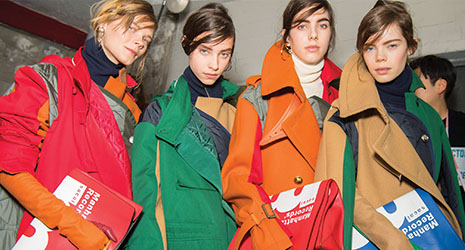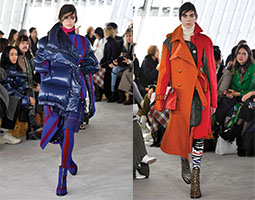Home > Highlighting JAPAN > Highlighting Japan July 2018 > The Evolution of Japonism
Highlighting JAPAN


A Global Fashionista Favorite from Japan
Designer and owner Chitose Abe’s brand, sacai, has caught and held the critical eye of fashion devotees worldwide. We asked her about sacai’s worldview.
WHEN Chitose Abe launched her label sacai in 1999, she and the brand had just five knitwear designs to offer. They steadily added new creations, however, and by 2004 had staged their first exhibition in Paris. In 2009 sacai started a line of menswear, and Abe also became the first Japanese person ever appointed as a designer for French apparel manufacturer and lifestyle brand Moncler—known for their famous down jackets—which boosted the label’s profile significantly.
Abe held a show at the Paris Collection in 2011, and since then she has gone on to stage shows at Paris Fashion Week and actively pursue overseas markets. In 2015 she was invited to an official dinner at the White House during Prime Minister Shinzo Abe’s visit to the United States. She has grown sacai into one of the most indispensable Japanese fashion brands around. In Japan, she established a flagship store in Tokyo’s trendy Aoyama district, and actresses started wearing sacai dresses at film festivals.
Since its foundation, sacai has stayed true to the concept of “designs that stand out in everyday life.”
“The clothes I make are clothes I would like to wear myself. No matter how innovative an idea may be or your ability to create it, I believe it’s meaningless unless it can actually be worn by people,” says Abe of the origins of the sacai style. “This value spreads to the underlying concept of the brand. I want my pieces to be worn in all sorts of daily situations rather than for just one specific occasion. I always keep this in mind while I’m creating clothes.”
The sacai philosophy on making clothes can also be glimpsed in their “hybrid” designs and active collaborations with other brands. For example, they create different silhouettes by combining contrasting materials or parts from different clothing items, such as sweats and pleats. The brand announced collaborations with Nike in 2015 and The North Face in 2017, and the limited collections they produced caught the imagination of people of all ages and completely sold out.
“I value craftsmanship that cannot be found anywhere else, that cannot be stereotyped and can only have come from sacai,” Abe explains. “Japanese people are very open when it comes to incorporating new cultural or street elements into fashion, and I think we’re good at bringing out that kind of ingenuity.”
As for why sacai’s creations resonate with so many people, Abe believes it is because a lot of women in the modern world take on a variety of roles in their lives.
“I myself am both a designer and the manager of a company. When I return home I am a mother, I am a woman. Women in the world, like me, are not just one-dimensional. We have various sides and face a variety of situations. That’s why I think sacai’s worldview and the clothes I make—the clothes I want to wear—resonate with them.”
The appeal of sacai has much to do with the way it communicates how women work and live, through Abe as a person. That’s probably why the brand is able to continue moving forward, vigorously and flexibly, through the fast-moving waters of the fashion industry. The label is likely to stay in the spotlight, broadcasting the “now” of Japan to the world.
© 2009 Cabinet Office, Government of Japan











